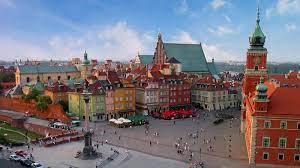Warsaw Old Town – what's worth seeing?

The Old Town began to be surrounded by defensive fortifications after the founding of the city (approximately 1300 year). In the sixteenth century, the former ramparts of clay and sand replaced the brick walls on a stone foundation, z prostokątnymi basztami i Barbican (foregate of the New Town Gate) designed by John the Baptist of Venice. From the second half of the eighteenth century, the walls were gradually dismantled. The present ones are a reconstruction from the years 1946- 1954, compiled as of the end of the 16th century. Relics of the Gothic bridge are visible. There are monuments on the walls: shoemaker Jan Kiliński, leaders of the townspeople in the Kościuszko Uprising 1794 year (carving chisel St.. Jackowski with 1935 year), and the Monument to the Little Insurgent (with 1983 year) according to the model of z 1946 year of the sculptor Jerzy Jarnuszkiewicz.
House ul. Piekarska 20 mieszczący Museum of Clocks and Artistic and Precise Crafts, decorated with a mosaic clock-chime (made in 1971 year) project K. Gąsiorowski.
Kompozycyjną oprawą Starego Miasta jest pseudo-klasycystyczna buildings along Podwale Street. It was built on the site of damaged houses, in years 1945- 1953, according to the project by arch. Jan Reda and J.. Idzikowski.
Castle Square it is originally a princely land. Buildings were built here along with the expansion of the Royal Castle under Sigismund III Vasa. The square has been regulated several times, among others, in the seventeenth century, when Sigismund's Column was erected, before the mid-nineteenth century, when the Feliks Pancer viaduct was built, after World War II in connection with the piercing of the tunnel of the W-Z Route (its shape was changed and moved by 6 Sigismund's Column), after 1983 year in connection with the reconstruction of the Castle (the lower parts of the Gothic bridge were unveiled at that time).
Column of King Sigismund III Vasa (foundation of his son Władysław IV) is a unique Baroque monument in Europe, which breaks with the traditional scheme of the monument to the ruler. The monument was created in the years 1643-1644 according to the urban design of Augustyn Locci and Konstanty Tencalla. On the Corinthian column (once made of red marble) about height 8,5 subway set sculpture of the king in archaized armor, height 2,75 metra. Model made by Clemente Molli, bronze casting Daniel Tym. The height of the column together with the plinth is 22 Meters. Collapsed in January 1945 year, was reconstructed in years 1948-1949: the rescued sculpture was placed on a new granite column from the Strzegoń mine and the whole was moved to the axis of Krakowskie Przedmieście, creating one of the most beautiful views of Warsaw.
Tenement houses surrounding the Castle Square were created in the years 1957-1960 as an architectural setting for the square. Pseudo-historic facades partly refer to tenement houses demolished in 1944 year, and partly they are contemporary fantasy: tenement house “At the Pelican” it was named after the addition of a new sculpture of a pelican, which was not here before. Edmund Burke performed the sgraffito.
